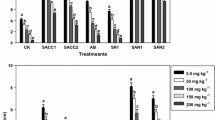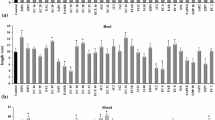Abstract
Lead (Pb) pollution is appearing as an alarming threat nowadays. Excessive Pb concentrations in agricultural soils result in minimizing the soil fertility and health which affects the plant growth and leads to decrease in crop production. Plant growth promoting rhizobacteria (PGPR) are beneficial bacteria which can protect the plants against many abiotic stresses, and enhance the growth. The study aimed to identify important rhizobacterial strains by using the 1-aminocyclopropane-1-carboxylate (ACC) enrichment technique and examine their inoculation effects in the growth promotion of maize, under Pb pollution. A pot experiment was conducted and six rhizobacterial isolates were used. Pb was added to 2 kg soil in each pot (with 4 seeds/pot) using Pb(NO3)2 at the rate of 0, 100, 200, 300, and 400 mg kg−1 Pb with three replications in completely randomized design. Rhizobacterial isolates performed significantly better under all Pb levels, i.e., 100 to 400 Pb mg kg−1 soil, compared to control. Comparing the efficacy of the rhizobacterial isolates under different Pb levels, rhizobacterial isolates having both ACC-deaminase and nitrogen-fixing activities (AN8 and AN12) showed highest increase in terms of the physical, chemical and enzymatic growth parameters of maize, followed by the rhizobacterial isolates having ACC-deaminase activity only (ACC5 and ACC8), and then the nitrogen-fixing rhizobia (Azotobacter and RN5). However, the AN8 isolate showed maximum efficiency, and highest shoot and root length (14.2 and 6.1 cm), seedling fresh and dry weights (1.91 and 0.14 g), chlorophyll a, b, and carotenoids (24.1, 30.2 and 77.7 μg/l), protein (0.82 mg/g), proline (3.42 μmol/g), glutathione S-transferase, peroxidase and catalase (12.3, 4.2 and 7.2 units/mg protein), while the lowest Pb uptake in the shoot and root (0.83 and 0.48 mg/kg) were observed under this rhizobial isolate at the highest Pb level (i.e., 400 Pb mg kg−1 soil). The results revealed that PGPR significantly decreases the deleterious effects of Pb pollution and increases the maize growth under all Pb concentrations, i.e., 100–400 Pb mg kg−1 soil. PGPR chelate the Pb in the soil, and ultimately influence its bioavailability, release and uptake. The PGPR having both ACC-deaminase and nitrogen-fixing abilities are more effective and resistive against Pb pollution than PGPR having either ACC-deaminase or nitrogen-fixing activity alone. The ACC enrichment technique is an efficient approach to select promising PGPR.














Similar content being viewed by others
References
Ahemad M (2012) Implications of bacterial resistance against heavy metals in bioremediation: a review. IIOAB J 3:39–46
Ahemad M, Malik A (2011) Bioaccumulation of heavy metals by zinc resistant bacteria isolated from agricultural soils irrigated with wastewater. Bacteriol J 2:12–21
Arnon DI (1949) Copper induced enzyme in isolated chloroplasts; polyphenol oxidase in Beta vulgaris. Plant Physiol 24:1–15
Bates L, Waldren RP, Teare ID (1973) Rapid determination of free proline for water-stress studies. Plant Soil 39:205–207
Belimov AA, Safronova VI, Sergeyeva TA, Egorova TN, Matveyeva VA, Tsyganov VE, Borisov AY, Tikhonovich IA, Kluge C, Preisfeld A, Dietz KJ, Stepanok VV (2001) Characterization of plant growth promoting rhizobacteria isolated from polluted soils and containing 1-aminocyclopropane-1-carboxylate deaminase. Can J Microbiol 47:642–652
Bindler R (2011) Contaminated lead environments of man: reviewing the lead isotopic evidence in sediments, peat, and soils for the temporal and spatial patterns of atmospheric lead pollution in Sweden. Environ Geochem Health 33:11–329
Bradford MM (1976) A rapid and sensitive method for quantitation of microgram quantities of protein utilizing the principle of protein–dye binding. Anal Biochem 72:248–254
Burd GI, Dixon DG, Glick BR (1998) A plant growth promoting bacterium that decreases nickel toxicity in seedlings. Appl Environ Microbiol 64:3663–3668
Cakmak I, Horst WJ (1991) Effect of aluminium on lipid peroxidation, superoxidase dismutase, catalase and peroxidase activities in root tips of soybean (Glycine max). Physiol Plant 83:463–468
Davies KG, Whitbread RA (1989) Comparison of method for measuring the colonization of root system by fluorescent pseudomonads. Plant Soil 116:239–246
Dell’Amico E, Cavalca L, Andreoni V (2008) Improvement of Brassica napus growth under cadmium stress by cadmium-resistant rhizobacteria. Soil Biol Biochem 40:74–84
Dworken M, Foster J (1958) Experiment with some microorganisms which utilize ethane and hydrogen. J Bacteriol 75:92–601
Filip Z (2002) International approach to assessing soil quality by ecological related biological parameters. Agric Ecosyst Environ 88:169–174
Glick BR (2003) Phytoremediation: synergistic use of plants and bacteria to clean up the environment. Biotechnol Adv 21:383–393
Glick BR (2012) Plant growth-promoting bacteria: mechanisms and applications. Hindawi Publishing Corporation, Scientifica
Grichko VP, Glick BR (2001) Amelioration of flooding stress by ACC deaminase-containing plant growth-promoting bacteria. Plant Physiol Biochem 39:11–17
Habig WH, Pabst MJ, Jakoby WB (1974) Glutathion S-transferases, the first enzymatic step in mercapturic acid formation. J Biol Chem 249:7130–7139
Hammerschmidt R, Nucckles F, Kuc I (1982) Association of enhance peroxidase activity with induced systemic resistance of cucumber to Colletotrichum largenarium. Physiol Plant Pathol 20:73–82
Hassan W (2013) C and N mineralization and dissolved organic matter potentials of two contrasting plant residues: effects of residue type, moisture and temperature. Acta Agric Scand B Soil Plant Sci 63:642–652
Hassan W, David J (2013) Effect of lead pollution on soil microbiological index under spinach (Spinacia oleracea L.) cultivation. J Soils Sediments 14:44–59
Hassan W, Akmal M, Muhammad I, Younas M, Zahaid KR, Ali F (2013a) Response of soil microbial biomass and enzymes activity to cadmium (Cd) toxicity under different soil textures and incubation times. Aust J Crop Sci 7:674–680
Hassan W, David J, Abbas F (2013b) Effect of type and quality of two contrasting plant residues on CO2 emission potential of Ultisol soil: implications for indirect influence of temperature and moisture. Catena 114:90–96
Hassan W, Chen W, Huang Q, Mohamed I (2013c) Microcalorimetric evaluation of soil microbiological properties under plant residues and dogmatic water gradients in Red soil. Soil Sci Plant Nutr 59:858–870
Hassan W, Chen W, Cai P, Huang Q (2013d) Oxidative enzymes, the ultimate regulator: implications for factors affecting their efficiency. J Environ Qual 42:1779–1790
Hassan W, Chen W, Cai P, Huang Q (2014a) Estimation of enzymatic, microbial and chemical properties in Brown soil by microcalorimetry. J Therm Anal Cal 116:969–988
Hassan W, Bano R, Khatak BU, Hussain I, Yousaf M, David J (2014b) Temperature sensitivity and soil organic carbon pools decomposition under different moisture regimes: effect on total microbial and enzymatic activity. CLEAN — Soil Air Water. doi:10.1002/clen.201300727
Hayat R, Ali S, Amara U, Khalid R, Ahmed I (2010) Soil beneficial bacteria and their role in plant growth promotion: a review. Ann Microbiol 60:579–598
Honma M, Shimomura T (1978) Metabolism of 1-aminocyclopropane-1-carboxylic acid. Agric Biol Chem 42:1825–1831
Komarek M, Ettler V, Chrastny V, Mihaljevic M (2008) Lead isotopes in environmental sciences: a review. Environ Int 34:562–577
Kuffner M, Puschenreiter M, Wieshammer G, Gorfer M, Sessitsch A (2008) Rhizosphere bacteria affect growth and metal uptake of heavy metal accumulating willows. Plant Soil 304:35–44
Li J, Ovakim DH, Charles TC, Glick BR (2000) An ACC-deaminase minus mutant of Enterobacter cloacae UW4 no longer promotes root elongation. Curr Microbiol 41:101–105
Majid NM, Islam MM, Rauf RA (2012) Evaluation of Jelutong (Dyera cotulata) as a phytoremediator to uptake copper (Cu) from contaminated soils. Aust J Crop Sci 6:369–374
Mayak S, Tirosh T, Glick BR (2004) Plant growth-promoting bacteria confer resistance in tomato plants to salt stress. Plant Physiol Biochem 42:565–572
Mia MAB, Shamsuddin ZH, Wahab Z, Marziah M (2010) Effect of plant growth promoting rhizobacterial (PGPR) inoculation on growth and nitrogen incorporation of tissue-cultured Musa plantlets under nitrogen-free hydroponics condition. Aust J Crop Sci 4:85–90
Nadeem SM, Zahir ZA, Naveed M, Arshad M, Shahzad SM (2006) Variation in growth and ion uptake of maize due to inoculation with plant growth promoting rhizobacteria under salt stress. Soil Environ 25:78–84
Nakano Y, Azada K (1987) Purification of ascorbate peroxidase in spinach chloroplasts: its inactivation in ascorbate depleted medium and reactivation by monodehydroascorbate radical. Plant Cell Physiol 28:131–140
Page AL, Miller RH, Keeney DR (1982) Methods of soil analysis—chemical and microbiological properties: Part 2, 2nd edn. Amer Soc Agron (ASA) No. 9, Madison
Penrose DM, Glick BR (2003) Methods for isolating and characterizing ACC deaminase-containing plant growth-promoting rhizobacteria. Physiol Plant 118:10–15
Pishchik VN, Vorobyev NI, Chernyaeva II, Timofeeva SV, Kozhemyakov AP, Alexeev YV, Lukinm SM (2002) Experimental and mathematical simulation of plant growth promoting rhizobacteria and plant interaction under cadmium stress. Plant Soil 243:173–186
Premono HME, Moawad AM, Vlek PLG (1996) Effect of phosphate-solubilizing Pseudomonas putida on the growth of maize and its survival in the rhizosphere. Indonesian J Crop Sci 11:13–23
Rajkumar M, Nagendran R, Lee KJ, Lee WH, Kim SZ (2006) Influence of plant growth promoting bacteria and Cr6+ on the growth of Indian mustard. Chemosphere 62:741–748
Raymond J, Siefert JL, Staples CR, Blankenship RE (2004) The natural history of nitrogen fixation. Mol Biol Evol 21:541–554
Regan DL (1988) Other micro-algae. In: Borowitzka MA and Borowitzka LJ edn, Microalgal Biotechnology, Cambridge University Press, Cambridge, pp. 135–150
Ribaudo CM, Krumpholz EM, Cassan FD, Bottini R, Cantore ML, Cura JA (2006) Azospirillum sp. Promotes root hair development into tomato plants through a mechanism that involves ethylene. J. Plant Growth Regul 25:175–185
Sahran BS, Nehra V (2011) Plant growth promoting rhizobacteria: a critical review. Life Sci Med Res 2011: LSMR-21
Saikia R, Kumar R, Arora DR, Gogoi DK, Azad P (2006) Pseudomonas aeruginosa inducing rice resistance against Rhizoctonia solani: production of salicylic acid and peroxidases. Folia Microbiol 51:375–380
Saleem M, Arshad M, Hussain S, Bhatti AS (2007) Perspective of plant growth promoting rhizobacteria (PGPR) containing ACC deaminase in stress agriculture. J Indian Microbiol Biotechnol 34:635–648
US Salinity Lab Staff (1954) Diagnosis and improvement of saline and alkali soils. USDA Hand Book No 60. Washington DC, USA, pp 160
Sarwar M, Arshad M, Martins DA, Frankenberger WT Jr (1992) Tryptophan-dependent biosynthesis of auxins in soil. Plant Soil 147:207–215
Sharma P, Dubey RS (2005) Lead toxicity in plants. Braz J Plant Physiol 17:35–52
Singh S, Sinha S (2005) Accumulation of metals and its effects in Brassica juncea (L.) Czern (cv. Rohini) grown on various amendments of tannery waste. Ecotoxicol Environ Saf 62:118–127
Smith SE, Read DJ (1997) Mycorrhizal symbiosis. Academic Press, London, p 605
Spaepen S, Vanderleyden J (2011) Auxin and plant–microbe interactions. Cold Spring Harb Perspect Biol 3(4). doi: 10.1101/cshperspect.a001438
Stefan M, Munteanu N, Stoleru V, Mihasan M (2013) Effects of inoculation with plant growth promoting rhizobacteria on photosynthesis, antioxidant status and yield of runner bean. Rom Biotechnol Lett 18(2)
Vessey JK (2003) Plant growth promoting rhizobacteria as biofertilizers. Plant Soil 255:571–586
Wang C, Knill E, Glick BR, Defago G (2000) Effect of transferring 1-aminocyclopropane-1-carboxylic acid (ACC) deaminase genes into Pseudomonas fluorescens strain CHAO and its gacA derivative CHA96 on their growth-promoting and disease suppressive capacities. Can J Microbiol 46:898–907
Wollum AG II (1982) Cultural methods for soil microorganisms. In: Page AL (ed) Methods of soil analysis: Part 2. Chemical and microbiological properties. Agronomy No 9, ASA, Madison, pp 781–802
Young SA, Guo A, Guikema JA, White F, Leach IE (1995) Rice cationic peroxidase accumulation in xylem vessels during incompatible interaction with Xanthomonas oryzae. Plant Physiol 107:1333–1341
Zahir ZA, Munir A, Asghar HN, Shaharoona B, Arshad M (2008) Effectiveness of rhizobacteria containing ACC-deaminase for growth promotion of pea (Pisum sativum) under drought conditions. J Microbiol Biotechnol 18:958–963
Author information
Authors and Affiliations
Corresponding author
Additional information
Responsible editor: Elena Maestri
Rights and permissions
About this article
Cite this article
Hassan, W., Bano, R., Bashir, F. et al. Comparative effectiveness of ACC-deaminase and/or nitrogen-fixing rhizobacteria in promotion of maize (Zea mays L.) growth under lead pollution. Environ Sci Pollut Res 21, 10983–10996 (2014). https://doi.org/10.1007/s11356-014-3083-5
Received:
Accepted:
Published:
Issue Date:
DOI: https://doi.org/10.1007/s11356-014-3083-5




